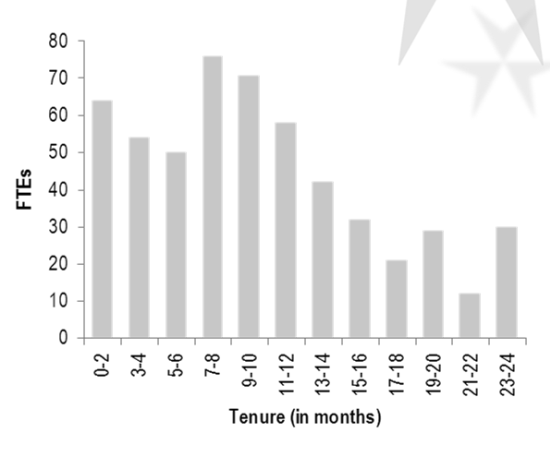In yesterday’s Advisor, Featured Consultant Joseph DiMisa warned against a $2-million mistake—hiring the wrong salesperson. Today, we discuss how he addressed a sales force turnover problem.
 |
Case Study: Company Situation
A large high-tech firm was experiencing a significant amount of annual turnover by their sales reps, says DiMisa, who is senior vice president and the head of the Sales Force Effectiveness Practice at Sibson Consulting. Initial analysis showed that the cost associated with the company’s turnover was more than $50 million a year in direct and indirect costs.
The company hired Sibson to review their compensation plans in order to determine how to adjust compensation to retain and attract the right sales talent. But the analysis of 2 years’ worth of sales rep data showed that compensation wasn’t the problem.
The first chart shows the turnover by tenure bucket. The company realized that most of their turnover occurred in the first year.
Looking to build and perfect that 2015 comp plan? Start with PayScale’s (free!) complete guide to compensation plans, Bring Back the Sizzle: PayScale’s Guide to Comp Plans That Get Workers Fired Up (In a Good Way). Learn More
Turnover by Tenure Bucket

Further study showed that the turnover was concentrated among those in the poorer performing quartiles.
And the second chart shows performance over time for the 25th, median, and 75th percentiles of performers.
Performance over Time

The top line represents the 75th percentile of performance, the middle line, median performance, and the bottom line, the 25th percentile of performance. The vertical axis is the percent of quota achieved.
What became clear was that the top performers showed themselves early—by the third month on the job, they reached quota and continued to meet and exceed quota. The median performers were likely to meet quota by the sixth month and were likely to continue to achieve quota.
The interesting thing they found was that those who did not achieve about 60 percent of quota by the third month were likely to never reach quota.
Why are you keeping your investments on those in the 25th percentile who will never get to quota? DiMisi asks. The strategy for the lower-performing group is to develop a performance plan at that early stage and exit them soon after, DiMisi says.
The overall conclusion of the study was that the recruiting and onboarding processes needed more attention, not the incentive system. To develop recruiting strategies, focus on the skills and competencies possessed by the top group, he says.
Of course, compensation is still important, and it doesn’t just affect your sales staff—it has huge implications for your entire organization. You want to attract and retain top talent while motivating employees to perform at their best. Making sure your best people are bringing home the bacon is critical to your organization’s success … but so is controlling the bottom line. How can you cook up a way to satisfy everyone?
PayScale, Inc., is here to help with their complimentary ebook, Bring Back the Sizzle: PayScale’s Guide to Comp Plans That Get Workers Fired Up (In a Good Way). Whether it’s your first comp plan or a revamp of an existing one, this eBook will help you produce a comp plan that’s a win/win for both you and your employees.
Your employees want to bring home a bigger slice of bacon, and you want to control costs—PayScale can help with both. Download their complimentary ebook, Bring Back the Sizzle. Download Now
With the recipes for success detailed in Bring Back the Sizzle (and some prep time), you can cook up a comp plan from scratch even if you’ve never done it before. You’ll learn how to:
- Gain executive support
- Define your comp strategy
- Develop a Market-Based Pay Structure
- Build Pay Ranges
- And much more!
By the end of this process, you’ll have a comp plan that will minimize your costs to get and retain top talent, drive employees to perform better—and you’ll have the confidence to talk comp with anyone!
Download the complimentary ebook now, courtesy of PayScale.
Creator of the largest database of individual compensation profiles in the world (containing 40 million salary profiles), PayScale, Inc., provides an immediate and precise snapshot of current market salaries to employees and employers through its online tools and software. PayScale’s products are powered by innovative search and query algorithms that dynamically acquire, analyze and aggregate compensation information for millions of individuals in real time.
